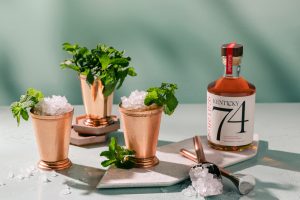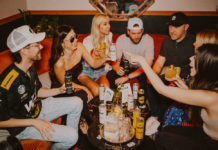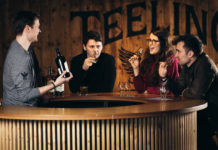The low-alc/no-alc movement has ushered in a new era of drinking. For those abstaining from alcohol, they are no longer limited to a soda, water, or a Shirley Temple. Instead, they can choose a nuanced non-alcoholic cocktail that is as well balanced and flavorful as its alcohol-containing counterpart. And it’s all thanks to non-alcoholic spirits like Spiritless.
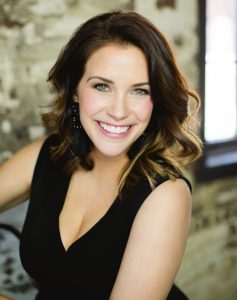
Founded in 2019 by Lauren Chitwood (CEO), Abbey Ferguson (CRO), and Lexie Larsen (COO), Spiritless’ debut product is Kentucky 74, a distilled non-alcoholic spirit that’s a perfect substitute for alcohol in a traditional bourbon cocktail. Kentucky 74 delivers a high-quality, smooth finish and is underpinned by subtle notes of caramel, vanilla, and oak.
We chatted with CEO Lauren Chitwood to learn more about the non-alcoholic brand, the non-alc/low-alc movement, and working as a woman in the spirits industry.
Read on to learn more, and be sure to check out the recipes at the end of the article!
Bar Business Media (BBM): What led you to jump into the non-alc, spiritless arena and develop Kentucky 74?
Lauren Chitwood (LC): So, we actually all came from the spirits industry in one way or another. Before starting Spiritless, we owned an experiential agency that worked with big beverage alcohol companies. But mostly we had an “a-ha” moment where we realized that we were also a part of the consumer trends that we were seeing. We were all young, we were trying to be more health conscious. We’re all moms a few times over and have spent many years of our lives sitting on the sidelines because of pregnancy or one reason or another. We really felt like it was just very obvious when we pulled up and looked that there was an opportunity here. And we ourselves were living examples of the need.
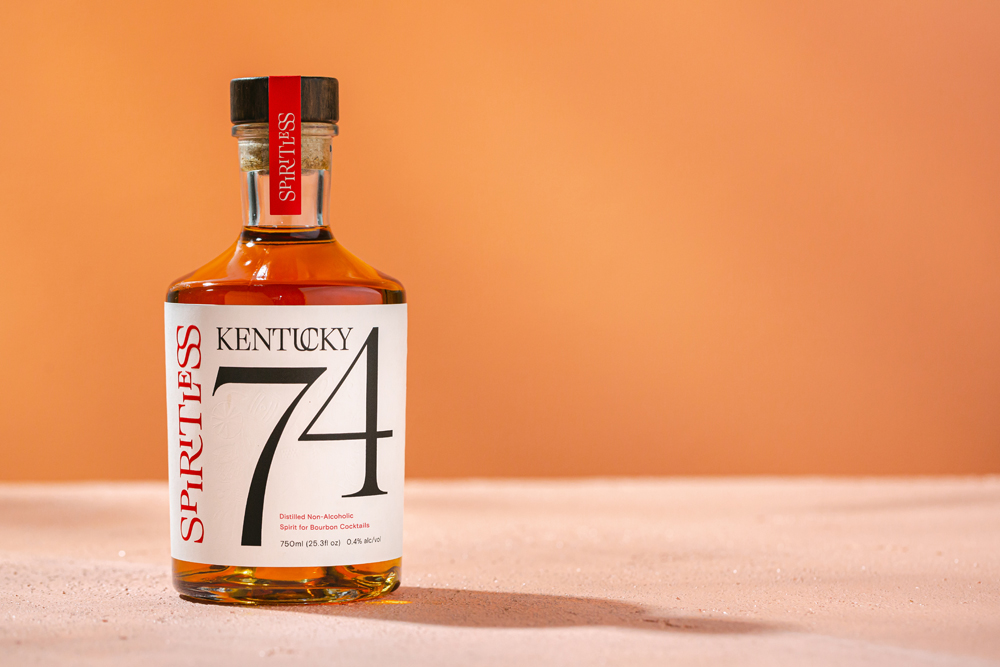
BBM: You mentioned being a mom and a woman in the industry. What does it mean to you to be a woman founder in what is still a male-dominated industry?
LC: Honestly, it delights me. I think that we have a fresh set of eyes and a fresh point of view that some of our counterparts don’t have. I think it’s really proven to keep us smart and agile and keep them on their toes. We don’t feel competitive towards the men, but we really see it as a strategic advantage. And you know, it’s been really fun to have them all be shocked about what we’re doing.
BBM: Do you have any advice for other women in the industry?
LC: I think that my biggest advice is just to have the mindset that you are absolutely entitled to be there. It’s sometimes hard to walk into a room filled with a bunch of men and not notice the difference between you and them. [Make sure] you’ve got the mindset that you’re just as much of a part of whatever that moment is as they are and not to let it really get to your head. Just keep your head down, and show up, and do the great job that you can do, and don’t think about it too much.
BBM: What are some of the reasons the non-alc movement has gained so much interest and growth over the last few years?
LC: I think that we all have just this new consciousness and awareness for when our bodies feel good and maybe when they don’t. Like we all wake up every day and do a self-assessment, right? Like, “Do I have COVID, am I healthy, am I well? What’s good? What’s bad about this? Am I worried about a symptom?” And so I think that that awareness and that consciousness about how we feel in our bodies has just become so much more present to this collective world that we’re living in. Those moments where we don’t feel well, or we don’t feel sharp, or we don’t feel well rested—all of those things that, for better or for worse, alcohol can really impact. I think that has allowed the conversation and allowed us to kind of pull up and say, “You know what, I actually felt a little bit better when I only have one glass of wine versus three because I sleep.”
I think aside from that, there’s also been a really nice de-stigmatization about…choosing to not participate with alcohol and to participate with something else. And feeling included and not feeling like you have to hide when you’re not drinking because that also has been a thing. And it’s still certainly a thing in certain circles. But I think it’s a combination of this heightened awareness and also the destigmatization of abstaining that has really helped this movement take off.
BBM: Do you have any advice for how the on-premise can present non-alc options on their menus and promote a product like Spiritless?
LC: I think that the first and most important thing is that they don’t bury the lead. So putting non-alc cocktails down by the Coke doesn’t help anyone, and it also doesn’t help them hold the floor on the price point and all the revenue that they’re wanting to gain by offering non-alcoholic spirits. I’m very passionate that certainly it can be in its own section of the menu, but obviously, it should not be down by your lemonade and your iced tea. It should be part of the cocktails as things are listed.
The labeling of those menus is also another important factor in the segmentation of cocktails—whether it just says low- or no-alcohol cocktails and avoiding the term “mocktail” or “alternative.” I think that the consumer is much more likely to participate and enjoy by avoiding those stigmatized labels. Nobody wants an alternative; alternative means that you’re having a second-class version. I think that low- and no-alcohol cocktails, just having that labeling feel as inclusive as possible to the rest of the menu, is super helpful.
We’ve got accounts that are doing it, and doing it well. We’ve got one account in Birmingham, Alabama. They’ve got an incredible non-alc cocktail list. They’re selling 28 non-alcoholic cocktails a night. That’s an insane number. And frankly, the big newsflash for them is, guys, this is real revenue for you. Because the people that are choosing that were going to be drinking water.
BBM: Do the bartenders and servers play a role in marketing non-alc spirits and cocktails as well?
LC: 100%. And here’s the big thing that we know the data supports and that I would love to scream from the rooftop: People choose to abstain, and it’s one moment at a time. So it is maybe between this and your next drink—that’s what we might call a spacer. Or it’s a Tuesday night and [you’re abstaining] until Wednesday, or it’s Monday to Friday, or it’s every day. We all have reasons that we choose to abstain. So again, making that more readily accessible and having service be understanding that they could choose this or that, it’s all for sale, and that it doesn’t mean anything, I think is really, really critical. There’s so many opportunities, too, where you can sell a non-alcoholic round to people that otherwise weren’t going to make that bar money.
When you approach a table and everybody is done with their drinks but obviously not done with the evening, and they’re pausing, what a great opportunity to offer something low proof or no proof.
I also talk about the final drink of the night. We’ve all been there where there’s a responsible party, and everybody wants to still linger, but somebody says, “Oh, well, we shouldn’t.” Again, that’s such an opportunity to generate revenue that people are missing.
And then the other thing that I like to remind people of is lowering the proof of some of these classic cocktails. [Chitwood uses the example of an Old Fashioned using half Spiritless, half bourbon.]
It’s less than 100 calories. It still feels really spirit forward, but I can have two or three of them over the course of an evening versus one and I have to stop. There are so many opportunities to keep people engaged, drinking longer, and selling more things when you bring these non-alcoholic spirits into your world. It’s good business for both the patron and the proprietor.
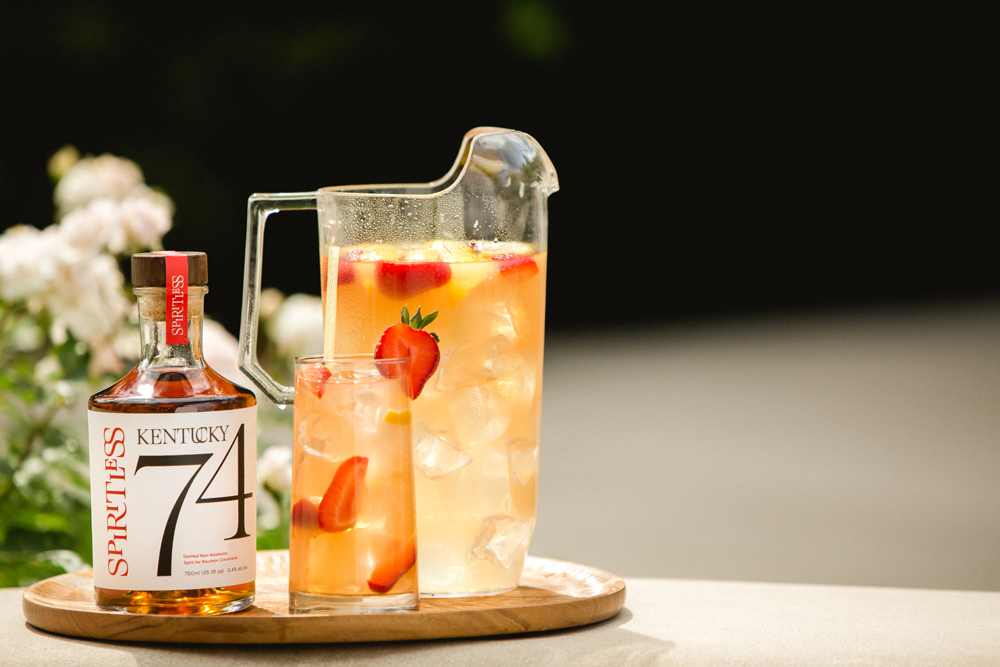
BBM: Any advice for crafting non-alcoholic cocktails?
LC: I would say that anytime you’re making a non-alc cocktail, one of the biggest things that you’re going to miss working with is that kind of viscosity and that mouthfeel. The reality is, ethanol is a pretty magical molecule, how it makes flavors interact, and the weight that it provides. Anytime you’re going to take that away, even when it’s with huge benefits, you’re obviously going to lose whatever that classic expectation was of the full-proof spirit. So I would encourage people to think very thoughtfully about using and crafting cocktails with the right types of sugars or other ingredients that may help add that weight. Even with a whiskey sour, getting that aquafaba or that egg white in there also helps add some of that weight. All those things are going to help you really feel like you’re having your cake and eating it too, and you’re not missing the ethanol.
BBM: Do you have any future plans to roll out additional non-alc spirits or other options?
LC: We do. We have a tequila that’s going to be out soon, and then we also have some incredible [canned] pour-over cocktails that will also be out by the end of the year.
There’s a little bit of a balancing act to making an incredible non-alc cocktail. It might be a slightly different proportion or a slightly different weight of ingredients from these classic standards. So we really felt like it was an incredible opportunity to take some of the guesswork out—especially when we know that the trade is just overworked and understaffed at the moment—to be able to bring those really quality experiences to the bar and take some of the lift out of it for them.
I’m just honored to be a part of it. It’s great to hear that it’s not lost on any of us that we’re helping people optimize for whatever they need, whether it’s inclusion, performance, sleep, or whatever. It’s just so great to be a positive light in the industry and for people.
Recipes
Try one of the Spiritless non-alcoholic cocktail recipes below! And note that all of these recipes can be adapted to what Spiritless likes to call HALFSIES—low-proof versions of the cocktail that use half Spiritless and half another full-proof spirit. To go HALFSIES on the recipes below, substitute the 2 oz of Spiritless with 1 oz Kentucky 74 and 1 oz of your favorite Kentucky Bourbon.
Spiritless Brown Derby
Ingredients:
2 oz. Spiritless Kentucky 74
1 oz. Grapefruit Juice
½ oz. Honey Syrup (2:1 honey to water)
Grapefruit Peel
Directions:
Shake ingredients with ice and strain into a chilled cocktail glass. Garnish with grapefruit peel.
Spiritless Mint Julep
Ingredients:
21/2 oz. Spiritless Kentucky 74
1/2 oz. Simple Syrup
6 Mint Sprigs
Powdered Sugar
Directions:
Gently muddle three to four sprigs with simple syrup in a Julep cup. Remove mint after muddling and pressing mint around cup walls. Fill halfway with crushed ice and add Spiritless Kentucky 74. Fill with crushed ice, garnish with extra sprigs, and sprinkle powdered sugar on top (optional).
Spiritless Flamingo Floatie
Ingredients:
11/2 oz. Spiritless Kentucky 74
4 oz. Fever Tree Pink Grapefruit Soda
2 Strawberries
2 Basil Sprigs
Directions:
Remove top and cut strawberry into quarters. Remove leaves from a basil sprig and combine with strawberry quarters and Kentucky 74 in a mixing tin. Muddle and strain liquid into a highball glass. Add ice and Fever Tree Pink Grapefruit Soda. Garnish with additional strawberry and basil sprig.


